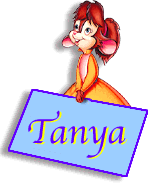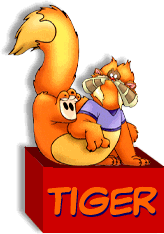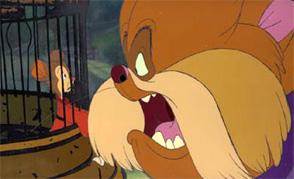
Cast * Interesting Facts * The Movie That Saved Disney Animation?

Cast * Interesting Facts * The Movie That Saved Disney Animation?
 |
 |
 |
Directed by: Don Bluth
Written by: Judy Freudberg & Gary
Goldman
Music by:James
Horner & Barry Mann
Released on: November 21, 1986
Running Time: 77 minutes
Budget: $9.6 million
Box-Office: $47.5 million in the U.S.,
$ million worldwide, $23 million in rentals
Fievel Mousekewitz... Phillip Glasser
Tanya Mousekewitz... Amy Green
Tiger... Dom DeLuise
Henri... Christopher Plummer
Papa Mousekewitz... Nehemiah Persoff
Mama Mousekewitz... Erica Yohn
Bridget... Cathianne Blore
 Warren
T. Rat... John Finnegan
Warren
T. Rat... John Finnegan
Gussie Mausheimer... Madeline Kahn
Tony Toponi... Pat Musick
Honest John... Neil Ross
Digit... Will Ryan
Moe... Hal Smith
![]() This film was
the first of an intended three to be made through Steven Spielberg's 'Amblin
Entertainment', and also the first to be backed by Morris Sullivan, to
form the new Bluth company 'Sullivan Bluth' after the previous Bluth company
had gone into bankruptcy following the bankruptcy of their laserdisc game
backers Cinematronics in 1984.
This film was
the first of an intended three to be made through Steven Spielberg's 'Amblin
Entertainment', and also the first to be backed by Morris Sullivan, to
form the new Bluth company 'Sullivan Bluth' after the previous Bluth company
had gone into bankruptcy following the bankruptcy of their laserdisc game
backers Cinematronics in 1984.
![]() Co-director Gary
Goldman recalled in August 2002 that "after NIMH,
our next feature was An American Tail. Another 'mouse' picture.
The crew back then did their share of groaning about drawing more mice.
The artists like to have some variety."
Co-director Gary
Goldman recalled in August 2002 that "after NIMH,
our next feature was An American Tail. Another 'mouse' picture.
The crew back then did their share of groaning about drawing more mice.
The artists like to have some variety."
![]() In 1986, An
American Tail became the highest-grossing animated feature of all-time
with $47 million.
In 1986, An
American Tail became the highest-grossing animated feature of all-time
with $47 million.
![]() Asked about Steven
Spielberg's involvement, Don Bluth recalled that "Steven did not make many
changes in the script or the storyboards. He would on occasion suggest
a change in a sight gag or a situation gag for the characters. It was his
first animated feature film experience and he has very curious about our
approach and the process. He had said from our meeting in September of
'82 that once a concept or story was selected (by him) we would make him
a beautiful movie. This meeting occurred because of Jerry Goldsmith's urging
Steven to see The
Secret of NIMH. He loved the film. He said he didn't think anyone
could produce such a movie and that he thought that the "art" of animation
production died with Walt Disney in 1966. We always welcomed his input.
He is Steven Spielberg. We didn't always agree but, we could always come
up with a satisfying compromise. [I] don't really remember any big disagreements
on Tail."
Asked about Steven
Spielberg's involvement, Don Bluth recalled that "Steven did not make many
changes in the script or the storyboards. He would on occasion suggest
a change in a sight gag or a situation gag for the characters. It was his
first animated feature film experience and he has very curious about our
approach and the process. He had said from our meeting in September of
'82 that once a concept or story was selected (by him) we would make him
a beautiful movie. This meeting occurred because of Jerry Goldsmith's urging
Steven to see The
Secret of NIMH. He loved the film. He said he didn't think anyone
could produce such a movie and that he thought that the "art" of animation
production died with Walt Disney in 1966. We always welcomed his input.
He is Steven Spielberg. We didn't always agree but, we could always come
up with a satisfying compromise. [I] don't really remember any big disagreements
on Tail."
![]() The movie received
an Academy Award Nomination for Best Song: "Somewhere Out There".
The movie received
an Academy Award Nomination for Best Song: "Somewhere Out There".

![]() Not surprisingly, the success of Don Bluth's original production led to
several mediocre sequels that the talented director had no involvement
in: 1991's An American Tail: Fieveld Goes West grossed $22 million
at the American box-office and will be best remembered for its impressive
voice cast, including John Cleese (Cat R. Haul), Amy Irving (Miss Kitty),
Jon Lovitz (T.R. Chula), the returning Phillip Glasser and Dom DeLuise,
and most importantly Jimmy Stewart (1908-1997) in his very last role as
Wylie Burp. An American Tail: The Mystery of the Night Monster
(1999)
and An American Tail: The Treasure of Manhattan Island (2000) both
went straight to video, with Party of Five's Lacey Chabert as Tanya.
Not surprisingly, the success of Don Bluth's original production led to
several mediocre sequels that the talented director had no involvement
in: 1991's An American Tail: Fieveld Goes West grossed $22 million
at the American box-office and will be best remembered for its impressive
voice cast, including John Cleese (Cat R. Haul), Amy Irving (Miss Kitty),
Jon Lovitz (T.R. Chula), the returning Phillip Glasser and Dom DeLuise,
and most importantly Jimmy Stewart (1908-1997) in his very last role as
Wylie Burp. An American Tail: The Mystery of the Night Monster
(1999)
and An American Tail: The Treasure of Manhattan Island (2000) both
went straight to video, with Party of Five's Lacey Chabert as Tanya.
![]() While the story
is set in 1885, the Victrola plays "The Stars and Stripes Forever," by
Sousa, which wasn't composed until 1896.
While the story
is set in 1885, the Victrola plays "The Stars and Stripes Forever," by
Sousa, which wasn't composed until 1896.
DID AN AMERICAN TAIL SAVE DISNEY'S ANIMATION UNIT?
 Don
Bluth explained in July 2002 that "Mr. Eisner, Wells, Katzenberg, et al,
had just arrived from Paramount and, when they saw the return on the company's
investment for The Black Cauldron,
they questioned whether or not that the company should continue in animation.
The
Fox and the Hound was a $12.5 million picture and was not very
successful at the time, either. It was Roy Disney that championed that
Division and the new-comers only looked at it as 'business' and in 1984,
it looked questionable. The idea that the new management at the Disney
Studio was interested in the art of animation is a very generous thought.
Roy Disney and the animation team, at Disney, were very protective of what
they were trying to make happen. But, with the new management team, it
was about making money. The financial success of An
American Tail DID inspire the new management to get behind the
Disney Animation efforts and support it, moving it forward at full steam.
Before An American Tail this management team, actually believed
that there was no audience for animation when, actually it was about MARKETING,
not just the quality of the films. Disney had lost their marketing edge
and had not really been marketing their animation very well. We remember
going to events during the '70s and being asked what we did. When we said
we were animators at Disney, the reply was always "Oh! Does Disney still
do animation?" In 1974, the last great Disney feature we had seen was Jungle
Book (1966). Aristocats
(1968) and Robin Hood (1973) weren't
blockbusters. And, the execs at Disney, after we finished The
Rescuers(1977), complained about the $7.5 million cost. We don't
take credit for the success of "Tail". We give the credit to Brad Globe,
the marketing director at Amblin', Spielberg's company and, to Universal,
for the clever ideas in getting marketing 'Partnerships' with McDonald's
and Sears for the marketing campaign on Tail. The joint financial
committment, between Universal, Sears and McDonald's was $45 million, to
be spent to build awareness for the film. This was the success of that
film and subsequent animated films from us and Disney. Universal only had
to recoup their own expenses. McDonald's and Sear's spent their money as
'advertising' to get the audience into their stores using Tail as
the lure. Disney actually successfully approached McDonald's and Sears
after the marketing campaign for Tail and paid them to become 'EXCLUSIVE'
to Disney. Obviously, the Disney management team saw the value in the NEW
marketing approach, using 'Promotional Partners.' Spielberg's name was
definately an asset, but with the critics, the film stood up to most criticisms."
Don
Bluth explained in July 2002 that "Mr. Eisner, Wells, Katzenberg, et al,
had just arrived from Paramount and, when they saw the return on the company's
investment for The Black Cauldron,
they questioned whether or not that the company should continue in animation.
The
Fox and the Hound was a $12.5 million picture and was not very
successful at the time, either. It was Roy Disney that championed that
Division and the new-comers only looked at it as 'business' and in 1984,
it looked questionable. The idea that the new management at the Disney
Studio was interested in the art of animation is a very generous thought.
Roy Disney and the animation team, at Disney, were very protective of what
they were trying to make happen. But, with the new management team, it
was about making money. The financial success of An
American Tail DID inspire the new management to get behind the
Disney Animation efforts and support it, moving it forward at full steam.
Before An American Tail this management team, actually believed
that there was no audience for animation when, actually it was about MARKETING,
not just the quality of the films. Disney had lost their marketing edge
and had not really been marketing their animation very well. We remember
going to events during the '70s and being asked what we did. When we said
we were animators at Disney, the reply was always "Oh! Does Disney still
do animation?" In 1974, the last great Disney feature we had seen was Jungle
Book (1966). Aristocats
(1968) and Robin Hood (1973) weren't
blockbusters. And, the execs at Disney, after we finished The
Rescuers(1977), complained about the $7.5 million cost. We don't
take credit for the success of "Tail". We give the credit to Brad Globe,
the marketing director at Amblin', Spielberg's company and, to Universal,
for the clever ideas in getting marketing 'Partnerships' with McDonald's
and Sears for the marketing campaign on Tail. The joint financial
committment, between Universal, Sears and McDonald's was $45 million, to
be spent to build awareness for the film. This was the success of that
film and subsequent animated films from us and Disney. Universal only had
to recoup their own expenses. McDonald's and Sear's spent their money as
'advertising' to get the audience into their stores using Tail as
the lure. Disney actually successfully approached McDonald's and Sears
after the marketing campaign for Tail and paid them to become 'EXCLUSIVE'
to Disney. Obviously, the Disney management team saw the value in the NEW
marketing approach, using 'Promotional Partners.' Spielberg's name was
definately an asset, but with the critics, the film stood up to most criticisms."
|
||||||||||||